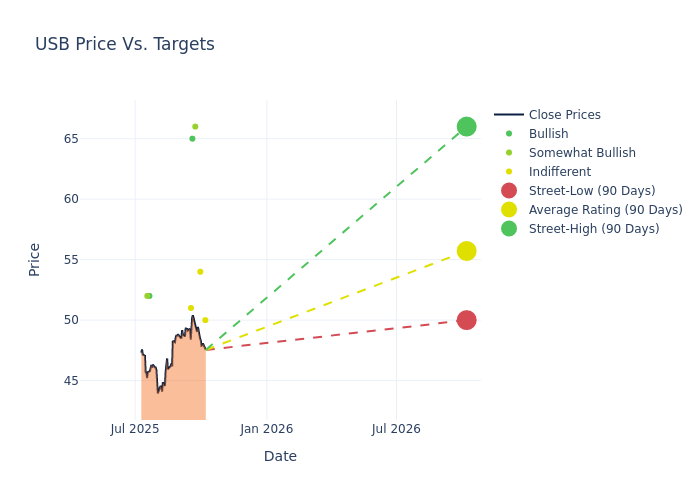Beyond The Numbers: 9 Analysts Discuss U.S. Bancorp Stock
Author: Benzinga Insights | October 07, 2025 04:00pm
U.S. Bancorp (NYSE:USB) has been analyzed by 9 analysts in the last three months, revealing a diverse range of perspectives from bullish to bearish.
The table below offers a condensed view of their recent ratings, showcasing the changing sentiments over the past 30 days and comparing them to the preceding months.
|
Bullish |
Somewhat Bullish |
Indifferent |
Somewhat Bearish |
Bearish |
| Total Ratings |
2 |
4 |
3 |
0 |
0 |
| Last 30D |
0 |
0 |
1 |
0 |
0 |
| 1M Ago |
1 |
1 |
2 |
0 |
0 |
| 2M Ago |
0 |
0 |
0 |
0 |
0 |
| 3M Ago |
1 |
3 |
0 |
0 |
0 |
Insights from analysts' 12-month price targets are revealed, presenting an average target of $58.11, a high estimate of $67.00, and a low estimate of $50.00. Observing a 3.77% increase, the current average has risen from the previous average price target of $56.00.

Breaking Down Analyst Ratings: A Detailed Examination
The standing of U.S. Bancorp among financial experts becomes clear with a thorough analysis of recent analyst actions. The summary below outlines key analysts, their recent evaluations, and adjustments to ratings and price targets.
| Analyst |
Analyst Firm |
Action Taken |
Rating |
Current Price Target |
Prior Price Target |
| Erika Najarian |
UBS |
Raises |
Neutral |
$50.00 |
$49.00 |
| Vijay Kumar |
Evercore ISI Group |
Raises |
In-Line |
$54.00 |
$49.00 |
| Chris Kotowski |
Oppenheimer |
Lowers |
Outperform |
$66.00 |
$67.00 |
| Keith Horowitz |
Citigroup |
Raises |
Buy |
$65.00 |
$59.00 |
| John McDonald |
Truist Securities |
Raises |
Hold |
$51.00 |
$49.00 |
| Chris Kotowski |
Oppenheimer |
Raises |
Outperform |
$67.00 |
$66.00 |
| Peter Winter |
DA Davidson |
Raises |
Buy |
$52.00 |
$49.00 |
| Chris Kotowski |
Oppenheimer |
Raises |
Outperform |
$66.00 |
$65.00 |
| Betsy Graseck |
Morgan Stanley |
Raises |
Overweight |
$52.00 |
$51.00 |
Key Insights:
- Action Taken: Analysts respond to changes in market conditions and company performance, frequently updating their recommendations. Whether they 'Maintain', 'Raise' or 'Lower' their stance, it reflects their reaction to recent developments related to U.S. Bancorp. This information offers a snapshot of how analysts perceive the current state of the company.
- Rating: Unveiling insights, analysts deliver qualitative insights into stock performance, from 'Outperform' to 'Underperform'. These ratings convey expectations for the relative performance of U.S. Bancorp compared to the broader market.
- Price Targets: Analysts gauge the dynamics of price targets, providing estimates for the future value of U.S. Bancorp's stock. This comparison reveals trends in analysts' expectations over time.
Assessing these analyst evaluations alongside crucial financial indicators can provide a comprehensive overview of U.S. Bancorp's market position. Stay informed and make well-judged decisions with the assistance of our Ratings Table.
Stay up to date on U.S. Bancorp analyst ratings.
About U.S. Bancorp
With assets of around $685 billion, U.S. Bancorp is one of the largest regional banks in the US with its footprint in 26 states. The bank's branch network is mostly in Midwestern and Western markets. U.S. Bancorp has a comprehensive product set, with offerings in retail and commercial banking, credit cards, mortgages, payment services, trust, and wealth services.
U.S. Bancorp's Financial Performance
Market Capitalization Analysis: Below industry benchmarks, the company's market capitalization reflects a smaller scale relative to peers. This could be attributed to factors such as growth expectations or operational capacity.
Revenue Growth: U.S. Bancorp's revenue growth over a period of 3M has been noteworthy. As of 30 June, 2025, the company achieved a revenue growth rate of approximately 2.0%. This indicates a substantial increase in the company's top-line earnings. When compared to others in the Financials sector, the company faces challenges, achieving a growth rate lower than the average among peers.
Net Margin: U.S. Bancorp's net margin lags behind industry averages, suggesting challenges in maintaining strong profitability. With a net margin of 24.85%, the company may face hurdles in effective cost management.
Return on Equity (ROE): U.S. Bancorp's ROE falls below industry averages, indicating challenges in efficiently using equity capital. With an ROE of 3.21%, the company may face hurdles in generating optimal returns for shareholders.
Return on Assets (ROA): U.S. Bancorp's ROA lags behind industry averages, suggesting challenges in maximizing returns from its assets. With an ROA of 0.25%, the company may face hurdles in achieving optimal financial performance.
Debt Management: U.S. Bancorp's debt-to-equity ratio is below the industry average. With a ratio of 1.45, the company relies less on debt financing, maintaining a healthier balance between debt and equity, which can be viewed positively by investors.
What Are Analyst Ratings?
Within the domain of banking and financial systems, analysts specialize in reporting for specific stocks or defined sectors. Their work involves attending company conference calls and meetings, researching company financial statements, and communicating with insiders to publish "analyst ratings" for stocks. Analysts typically assess and rate each stock once per quarter.
Beyond their standard evaluations, some analysts contribute predictions for metrics like growth estimates, earnings, and revenue, furnishing investors with additional guidance. Users of analyst ratings should be mindful that this specialized advice is shaped by human perspectives and may be subject to variability.
Which Stocks Are Analysts Recommending Now?
Benzinga Edge gives you instant access to all major analyst upgrades, downgrades, and price targets. Sort by accuracy, upside potential, and more. Click here to stay ahead of the market.
This article was generated by Benzinga's automated content engine and reviewed by an editor.
Posted In: USB





